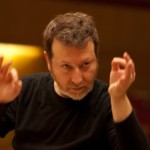By: Edna Landau
To ask a question, please write Ask Edna.
I am frequently asked what it takes to start a concert series. Having spoken to a good number of artists who have done so, I would say that the main basic ingredients are passion, determination, hard work, resourcefulness, excellent networking skills and perhaps, most importantly, a great idea or anticipation of a need. Anyone who has started their own series has literally thrown themselves into it, believing that the community they are targeting, and possibly even the world beyond, will be richer as a result of it. In this column, I have chosen to highlight the Cypress String Quartet, architects of the Call and Response and the Salon Series in San Francisco, and pianist Orli Shaham, founder of Baby Got Bach in New York City, designed for three to six year olds.
The Cypress String Quartet, now in its seventeenth season, has adopted an entrepreneurial approach to the development of their career since the very beginning. Early on, they shared a passion for commissioning new music but were drawn to the idea of linking the commissions to great works of the past. This led to their annual Call and Response concert, conceived as the commissioned composer responding to the call of the older work. To date, the Quartet has commissioned 14 works for the series. This year’s concert features the World Premiere of a new work for String Quartet and Voice by the Pulitzer prizewinning composer Jennifer Higdon, based on poetry of former American Poet Laureate W.S. Merwin, heard alongside Dvorak’s The Cypresses, twelve Moravian poems set by the composer as love songs for string quartet. The Cypress Quartet’s annual Call and Response concert at the Herbst Theatre is the culmination of dozens of outreach presentations in area schools which are prepared in advance with lesson plans and listening guides supplied by the Quartet, aided by an intern. Students who attend the concert are given tickets free of charge. A typical concert finds as much as half the audience under the age of eighteen, seated next to regular subscribers and listening to a program that might pair Beethoven’s Op. 131 with George Tsontakis’s String Quartet #5 (commissioned by the Cypress String Quartet). The educational component is relatively new for the Quartet, a result of successful fundraising stimulated by a very dedicated Board of Directors. However, before the Quartet obtained 501(c)3 status, contributions and grants were received via the San Francisco Friends of Chamber Music, which acted as a fiscal sponsor. Subsequent to that, but before becoming non-profit, the Quartet became a legal partnership. All concert income was split five ways so that even a modest sum could be set aside to defray expenses, which included the cost of a part-time assistant. Sometimes the Quartet had to be flexible about their share. The Quartet’s current Board initially started out as just friends, who followed and encouraged the ensemble since the beginning. It is the current Board chairman who encouraged the Quartet to give a series of salon concerts in New York 2 ½ years ago (which included three New York premieres), and who was the source of inspiration for the Quartet’s nine self-presented salon concerts in San Francisco this year, taking place in unusual, intimate venues and followed by (donated) wine and chocolate receptions. While the Quartet no longer sets up chairs for their own concerts, and the venues are generally donated, they tell me that they still may pick up programs from the printer from time to time. What advice do they give to emerging artists? Dream really big and then figure out how to get there, asking for help and advice all along the way.
Pianist Orli Shaham credits her publicist, Gail Wein, with the idea of a concert series for 3-6 year olds, launched three years ago at Le Poisson Rouge in New York. Ms. Wein was attending a concert at LPR one night, together with friends who had children the same age as Ms. Shaham’s three year old twins, and thought why not have concerts here for kids? Ms. Shaham, who had already been contemplating the lack of musical activities for the 3-6 year old set, loved the idea. So did LPR, who already had a Sunday afternoon pop music series called “Baby Loves Disco”. Ronen Givony came up with the name for the new series and LPR hosted the first two seasons, which featured Ms. Shaham performing together with guest artists and young musicians from the Carnegie Hall/Weill Institute Academy program. Each “Baby Got Bach” concert begins with thirty minutes of musical activities from which the young participants can choose, such as composing and performing a song or playing a musical instrument. The youngsters are actually given a colorful booklet called a Passport, which they get stamped when they visit a particular music station. Once they are sufficiently tired out (Executive Director Gail Wein’s words!), they listen attentively to a 40 minute concert of short selections which always begin with Bach and often include specialy commissioned music that may involve audience participation.
Like the Cypress Quartet, Orli Shaham launched “Baby Got Bach” with fiscal sponsorship, in her case from Fractured Atlas. (She is now working on obtaining 501(c)3 status.) The Centene Charitable Foundation helped launch the series in New York and inaugurate a new series in St. Louis. (“Baby Got Bach” has also taken root at the Aspen Music Festival, which Ms. Shaham visits each summer.) In New York, the series has now moved to the 92nd Street Y, which provides an infrastructure (and subscription base) that enables Ms. Shaham, its Artistic Director, to spend less time on logistics and more time on expanding the number and artistic quality of the programs, often involving faculty members of its School of Music. In reflecting on the past three years, she told me: “When you start something like this, passion is critical. It still sustains me today. For the hour or so that the children are with us, I can’t imagine them doing anything more meaningful. The programs also enrich time spent with my own children, who sometimes assist in preparing concert materials.” It is not important to her whether any of the children who participate in “Baby Got Bach” become musicians, but she feels confident that this early musical experience stands a good chance of creating in them a lifelong love of music.
To ask a question, please write Ask Edna.
© Edna Landau 2013



Jansons! Petrenko! Gergiev!
Wednesday, January 23rd, 2013By ANDREW POWELL
Published: January 23, 2013
MUNICH — With the city council’s blessing today of Valery Gergiev’s hire as the next Chefdirigent of the Munich Philharmonic, all three of the Bavarian capital’s globally renowned orchestras will be in Soviet-born hands by late 2015. This September, 40-year-old Kirill Petrenko of Omsk, Siberia, finally takes over the theater-based Bavarian State Orchestra; his appointment was announced in 2010. Riga-born Mariss Jansons, 70, has been Chefdirigent of the Bavarian Radio Symphony Orchestra since 2003; his present contract is expected to be lengthened, reflecting a collegial tenure. (Munich’s three other professional orchestras, the Münchener Kammerorchester, the Münchner Rundfunk-Orchester and the Münchner Symphoniker, have German conductors.)
The when and who of Gergiev’s appointment, leaked last week by the Abendzeitung newspaper, are a surprise. It was only four months ago that Lorin Maazel began his leadership of the MPhil. Contrary to one London report, Maazel was never announced as “temporary” Chefdirigent. His main contract covers the period 2012–15, and he additionally helped during the sudden gap that followed predecessor Christian Thielemann’s deeply lamented exit. It is not clear whether the 82-year-old French-born Pittsburgher would have preferred to retain the position. Anyway, recent Munich concerts led by him have lacked spark.
Moscow-born Gergiev, 59, is another prominent name for Munich but hardly one associated with the Beethoven-Brahms-Bruckner repertory that has defined the MPhil in its finest seasons, under Ferdinand Löwe (1908–14), Rudolf Kempe (1967–76) and Thielemann (2004–11). He is not known for Mozart or Schubert and is no Mahlerian either. A 2010 Verdi Requiem at the MPhil’s acoustically appalling Gasteig home suffered from misshapen phrases and apparent under-rehearsal. Not even a 2011–12 Shostakovich cycle, divided between the MPhil and the Mariinsky Orchestra, brought consistently probing and satisfactory results. But Gergiev’s finger-wiggling, turn-the-page spontaneity can work wonders in coloristic music or in episodic works, or in passages laden with irony or humor. His Mussorgsky and Prokofiev are unsurpassed, his Rimsky-Korsakov and Tchaikovsky much admired. The conductor is surprisingly adept, too, in certain scores by Berlioz and Wagner.
Gergiev will relinquish his job as principal conductor of the London Symphony Orchestra, it seems, near the time his new duties start, which the Abendzeitung gives as 2015. The MPhil job has an undisclosed contract length; it paid a reported €800,000 annually during the last Thielemann years.
Photo © Landeshauptstadt München
Related posts:
Gergiev, Munich’s Mistake
Berlin’s Dark Horse
MPhil Vacuum: Maazel Out
Maazel: ’Twas Always Thus
Gergiev Undissuaded
Tags:Abendzeitung, Bavarian Radio Symphony Orchestra, Bavarian State Orchestra, Bayerisches Staatsorchester, Christian Thielemann, Commentary, Kirill Petrenko, London Symphony Orchestra, Lorin Maazel, Mariinsky Orchestra, Mariss Jansons, München, Münchner Philharmoniker, Munich, Munich Philharmonic, News, Symphonie-Orchester des Bayerischen Rundfunks, Valery Gergiev
Posted in Munich Times | Comments Closed